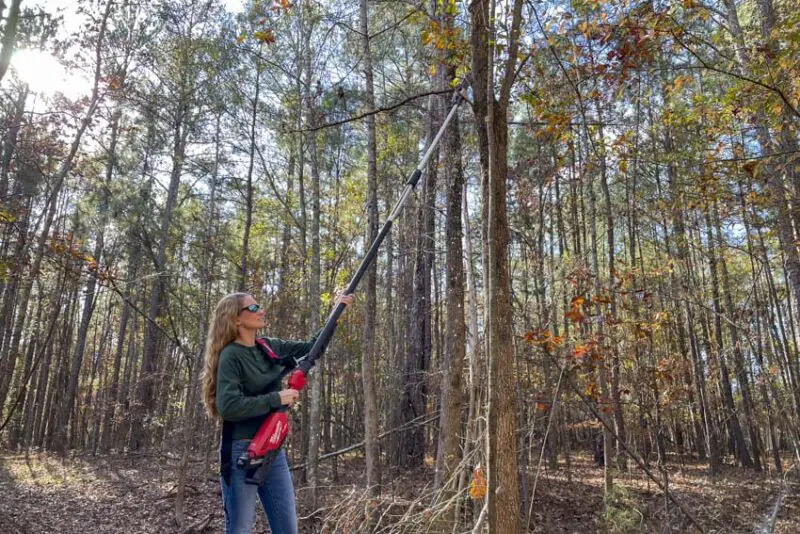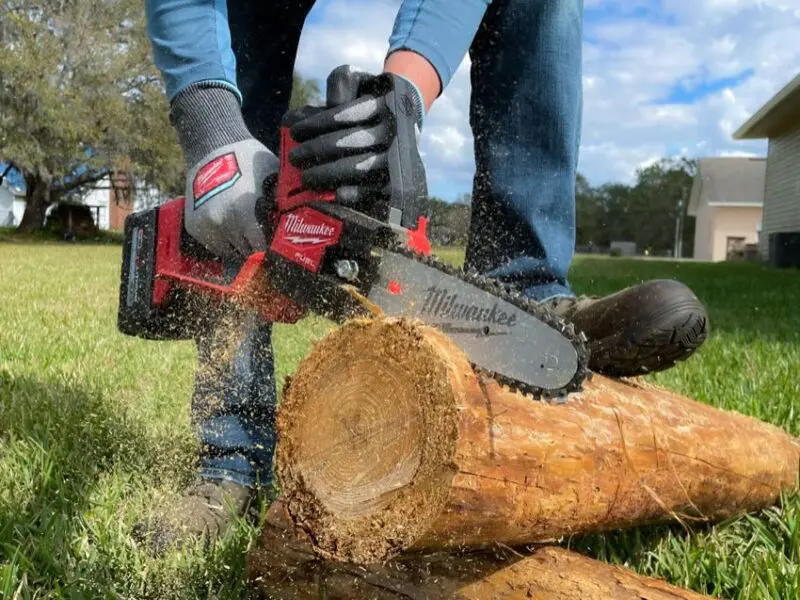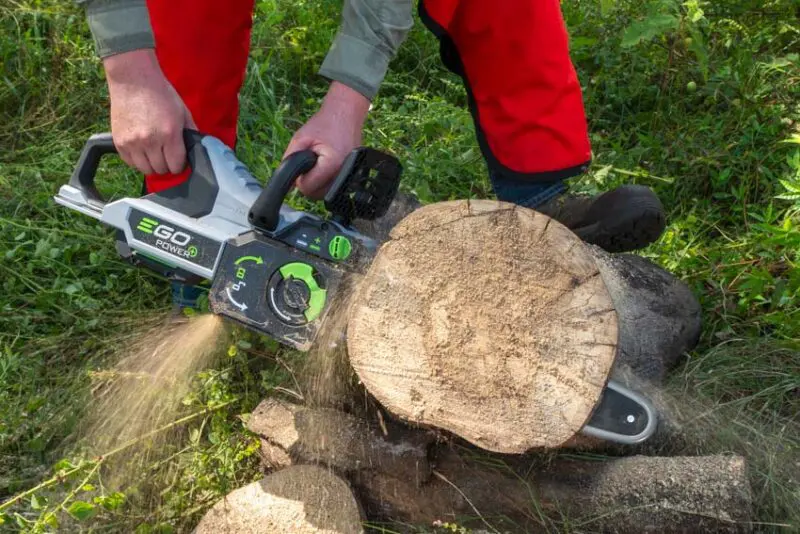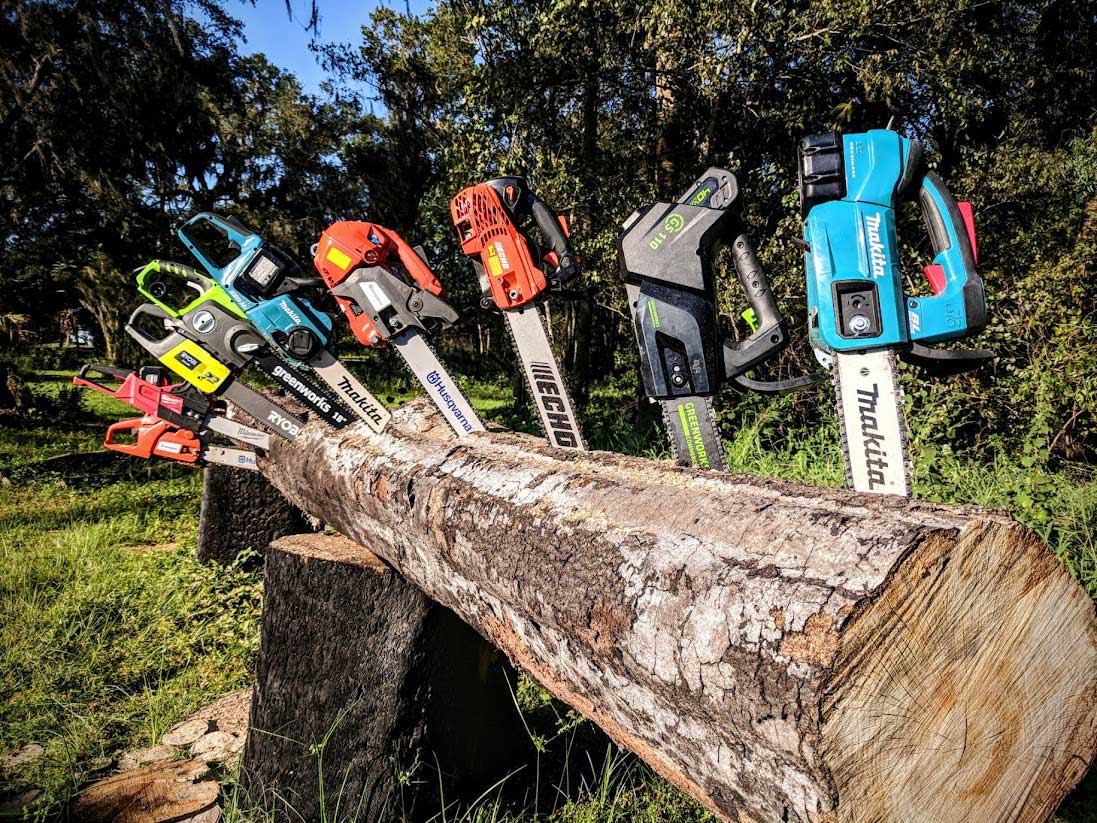Boy, did I open a can of worms when I directed our team to start searching and testing to determine the best battery-powered chainsaw. Not that long ago, there weren’t that many cordless chainsaws, and even fewer had high enough performance to warrant replacing gas saws.
Fast forward to 2024, and cordless chainsaws meet and even exceed gas performance all the way up to 20-inch models. Most recently, saws have hit the market that can replace gas tools even in the farm and ranch class. Our team of experts got together to hash out which cordless chainsaws we feel are the very best in the industry.
Want even more chainsaw recommendations? Check out our Best Chainsaw main page for options that include gas models!
Our Top Picks for Best Cordless Chainsaw
- Best for Pros: Stihl 20-Inch MSA 300 C-O
↓ Jump to this Chainsaw - Best Battery Top Handle: Husqvarna T540i XP
↓ Jump to this Chainsaw - Best Pole Saw: Milwaukee M18 Fuel Telescoping 3013
↓ Jump to this Chainsaw - Best for Home Use: EGO 56V 20-inch CS2005
↓ Jump to this Chainsaw - Best Pruning Saw: Milwaukee M18 Fuel Hatchet
↓ Jump to this Chainsaw - Best for the Money: EGO 56V 16-inch CS1613
↓ Jump to this Chainsaw
Best Overall – Our Pro Pick

Stihl 36V Brushless 20-inch Chainsaw MSA 300 C-O
- Dry Weight: 9.92 lbs
- Weight w/AP 500 S Battery: 14.33 lbs
- Chain Speed: 30 m/s (98.4 fps)
- Bar Length: 16–20 in.
Pros can finally buy reliable, powerful 20-inch cordless chainsaws. Of the available models, I prefer Stihl as my top choice for professionals over similar battery-powered chainsaws from DeWalt or Greenworks Commercial. Aside from hitting the 20-inch mark, the MSA 300 C-O has enough power to replace most farm and ranch gas saws. The fact that you also gain access to the vast Stihl dealer network makes this an even wiser choice.
The MSA 300 C-O has 3 different performance settings. This gives you options when you want to prioritize runtime over power. And believe me — runtime is the only downside to running this battery-powered chainsaw over a gas model. It has all the power and cutting speed you need.
I like the LED screen that clearly displays the power status, mode, and chain brake position. It even gives you a low oil alert. For anyone managing inventory, this Stihl chainsaw supports the company’s Connector 2 A Bluetooth module. Stihl also introduced the AP 500 S battery when they first debuted this saw. That was fortunate as that particular battery helps the MSA 300 C-O shine when using a larger 20-inch bar and chain. I recommend using this advanced power source if you want the most possible performance this saw has to offer.
Reasons to Buy
- Excellent power (AP 500 S battery)
- Extensive dealer support
- 3 performance modes
- Connector 2 A smart tool tracking
Consider Alternatives if…
- You don’t want to pay a premium
- You only intend occasional use of the saw
Best Battery Top Handle Chainsaw

Husqvarna 40V Top-Handle Chainsaw T540i XP
- Dry Weight: 5.51 lbs
- Weight w/4Ah Battery: 11.81 lbs
- Chain Speed: 24 m/s (79 fps)
- Bar Length: 12–16 in.
The Husqvarna 540i XP is the best cordless top-handle chainsaw currently available. It’s not quite as powerful as the Greenworks Commercial 82V. It’s also not as compact as the Echo 56V top handle (which looks like a toy even if it doesn’t perform like one). However, I think the Husqvarna’s balance of 40cc power, diminutive weight, and 12–16-inch bar options make it an excellent choice for arborists.
I also love that Husqvarna gives you the option to use a backpack battery and shift some of the weight off the saw. It’s not terribly practical when climbing but can be handy for ground-level work. Overall, the whole package Husqvarna offers with this tool makes it a solid choice. I love the built-in attachment points for tethering and the low vibration. If you connect it to your Husqvarna Fleet Services software, it can even track the last known tool location and help with inventory management.
Reasons to Buy
- Ample power
- Excellent dealer support
- Low vibration
- Retained bar nuts
Consider Alternatives if…
- You need premium power or a longer bar
- You’re not a professional
- Budgets are tight
Best Battery Pole Saw

Milwaukee M18 Fuel Telescoping Pole Saw 3013
- Max length: 13 ft (16 ft reach)
- Weight w/o battery: 16 lbs
- Chain Speed: 25 m/s (82 fps)
- Bar Length: 10 in.
When it comes to the best battery pole saw, multi-head systems are an excellent platform. However, most professional crews prefer dedicated tools to attachment systems. If that sounds like you, check out Milwaukee’s M18 Fuel Telescoping Pole Saw. It’s a 9- to 13-foot telescoping system (full length, not just reach) that reaches significantly higher than most of its competition.
The performance of this pole saw is impressive. Using a single 18V battery, its 10-inch bar delivers 2.3 HP, torque levels of 1.9 Nm, and speeds up to 25 m/s. It’s powerful and fast, and after making a few cuts, you’ll wonder why you didn’t switch to battery power sooner. Perhaps it’s because the Milwaukee 3013 wasn’t available until late 2023, so we’ll forgive you for holding out until now.
Looking for a battery-powered pole saw for home use? Take a closer look at the EGO 56V telescoping pole saw with a total reach of up to 16 feet! It features a carbon fiber shaft as well as an LED cutline indicator.
Reasons to Buy
- Outstanding cutting power and speed
- 16-foot reach
- Excellent sightline to the cut
- Beefy branch hook
- Inline design fits inside a 6-inch diameter conduit carrier
Consider Alternatives if…
- No significant drawbacks
Best Cordless Chainsaw for Home Use

EGO 20-inch Farm & Ranch Chainsaw CS2005
- Dry Weight: 13.1 lbs
- Weight w/6Ah Battery: 19.4 lbs
- Chain Speed: 25 m/s (82 fps)
- Bar Length: 20 in.
The EGO CS2005 chainsaw ramps its 0.050 gauge full chisel tooth chain up to 25 m/s almost instantaneously. We expect that from farm and ranch gas chainsaws, but battery saws have traditionally “spun up” more gradually. Not so with this saw from EGO — as Josh on our crew said repeatedly in his video review. The company also fits a 3/8-inch pitch chain to this tool, making it easy to find a replacement when you can no longer sharpen it.
It surprised me a bit to see just how much this saw improved performance over the 18-inch EGO that I already thought was pretty solid. If you’ve used other EGO’s previous battery-powered chainsaws, prepare yourself for a cutting experience on a completely different level.
A few other notables include retained bar nuts, three cutting speeds, and deep steel bucking spikes. With this major overhaul, the EGO 20-inch chainsaw shows off some true farm and ranch qualities, earning its spot for home users in our top cordless chainsaws list.
Reasons to Buy
- Excellent cutting power
- Zero ramp-up time
- Three cutting speeds
- Omnidirectional chain brake
- Onboard tool storage
- Retained bar nuts
Consider Alternatives if…
- A heavier saw at 19.4 lbs loaded seems too much
Best Mini Chainsaw for Pruning

Milwaukee M18 Fuel Hatchet 8-inch Pruning Saw 3004
- Dry Weight: 5.1 lbs
- Weight w/8.0Ah Battery: 7.4 lbs
- Chain Speed: 5 m/s (16.25 fps)
- Bar Length: 8 in.
I first got my hands on this saw at a Milwaukee Pipeline media event. It’s almost unfair to call the Milwaukee M18 Fuel Hatchet a pruner. It’s more like the best mini chainsaw we’ve ever used. While it has the general form factor of other popular mini-chainsaw pruners that have hit the market over the last few years, it’s on a completely different performance level. I love the full-house 3/8″ chain that devours wood and the metal bucking spikes that let you easily leverage cuts.
While it’s certainly useful as a pruner when manual pruners or hedge trimmers can’t cut it, landscaping crews can also use it for limbing duties on the ground or working at height. In many ways, the M18 Fuel Hatchet bridges the gap between pruners and top-handle chainsaws. Grab the smaller M12 Hatchet if you don’t need this much power and are already on Milwaukee’s 12V tool platform.
Reasons to Buy
- Quick cutting despite the slower chain speed
- Super-convenient to use for climbing
- Remarkably lightweight compared to a top-handle chainsaw
Consider Alternatives if…
- You regularly need to tackle limbs larger than 8 inches in diameter
Best Cordless Chainsaw for the Money

EGO 56V 16-inch Battery-Powered Chainsaw CS1613
- Dry Weight: 8.9 lbs
- Weight w/4.0Ah Battery: 13.7 lbs
- Chain Speed: 20 m/s (65.6 fps)
- Bar Length: 16 in.
EGO already had a solid 16-inch chainsaw on the market, but they released a new one in 2022 that made two big strides. First, it upped the performance to compete with (and even beat) gas saws in the 40cc class. Second, they added some much-needed features like a flip-top oil lid and metal bucking spikes.
Having used both saws, I like the performance bump and the features tweak that brings this saw in line with what I wanted to see. With a kit price well under $300, it’s almost impossible to resist as a consumer looking to get into a battery-powered chainsaw. As our pick for the best value you can find in a battery-powered chainsaw, it lacks much competition.
If getting the most bang for your buck is your highest priority, this is your chainsaw. I prefer retained nuts over a tool-free chain tensioner, but it’s easily overlooked for this price.
Reasons to Buy
- More power than the previous 16-inch model
- Flip-top oil reservoir cap
- Metal bucking spikes
- Tool-free chain tensioning with easier adjustments than the previous design
Consider Alternatives if…
- You hate getting a great deal?
- You insist on having captured bar nuts
Our Process and the Nitty Gritty
- Why You Can Trust Pro Tool Reviews
- More Battery Chainsaws We Recommend
- Best-selling Battery-Powered Chainsaws
- What to Look for When Buying a Cordless Chainsaw
Why You Can Trust Pro Tool Reviews
Since 2008, Pro Tool Reviews has done hands-on testing of power tools, hand tools, and accessories alongside reporting on industry news in the construction, automotive, and lawn care industries. Our Pro reviewers work in the trades and have the skills and experience to know whether tools can perform well in the field. It’s all about giving you a legitimate recommendation and our honest opinion of each product.
We work with more than two dozen professional contractors around the United States who review products for us on real jobsites and consult with us on testing methods, procedures, and rankings. We’ll provide more than 700 pieces of new content this year absolutely free for our readers—including objective evaluations of individual tools and products.
The end result is information you can trust because of the editorial, scientific, and real-world professional experience we collectively utilize each and every time we pick up and test a tool.
More Battery-Powered Chainsaws We Recommend
Best DeWalt Cordless Chainsaw – 60V Max Brushless DCCS677
Without a doubt, DeWalt’s 60V Max 20-inch cordless chainsaw (DCCS677) is the best model in Yellow’s lineup. As one of three professional battery-powered 20-inch chainsaws targeting the farm and ranch class, it’s in an elite class and it happens to be the least expensive model.
In designing the saw, DeWalt’s development team used the largest brushless motor in any tool they have…period. Along with a list of features that verify its professional pedigree, it’s also the first DeWalt chainsaw to come with a case. If you bleed yellow, I can see why you might want this saw.
Best Echo Cordless Chainsaw – 56V Brushless DCS-2500T
Echo made a sudden and decisive move with its 56V eForce system (not compatible with its earlier 58V tools). They have several chainsaw offerings. And while I do like their 18-inch model, it’s the Pro-focused X-Serires 12-inch top handle that steals the show.
The top handle is my personal favorite saw for portability. Like the 25cc gas-powered CS-2511T, the battery-powered DCS-2500T looks deceptively like a toy. However, Echo delivers features like a muscular brushless motor and drop protection (including a quickdraw harness ring) that you expect from a professional top handle chainsaw.
When I say this saw is lightweight — I mean it’s very lightweight at just 7.3 pounds with the battery installed! It’s definitely not your least expensive top-handle option, but Echo clearly designed it with the demands of professional arborists in mind.
Greenworks Commercial 82-Volt 20-Inch Chainsaw 82CS34
In late 2021 at GIE, DeWalt, Greenworks Commercial, and Stihl all announced new 20-inch battery-powered chainsaws with the power to take on the farm and ranch class. All three also claimed to have the most power, and as the dust settled, Greenworks Commercial’s had the highest-rated power.
In addition to having higher power, it’s also a couple of hundred dollars less than Stihl’s 20-inch model. It gets into a range that even homeowners with large properties to maintain might be tempted to step up.
As a side note, Greenworks also has a 20-inch chainsaw now available for its 60V residential lineup.
Best Makita Cordless Chainsaw – 40V max XGT GCU04
I’ve tested and used Makita 18V and 36V chainsaws for years. The newer 40V max XGT line definitely has the best options for Team Teal. The GCU04 steps up with 42cc gas equivalent power thanks to its specially-designed brushless motor. It sports an 18-inch bar with chain speeds up to 5020 fpm (25.5 m/s).
This model has dual bar studs with captured nuts. If you prefer tool-free chainsaw tensioning, you can get the same performance with that feature in the GCU06.
Best Milwaukee Cordless Chainsaw- M18 Fuel 2727
Milwaukee had one of the first really great cordless chainsaws and the M18 Fuel 2727 is still an excellent choice. It sports a brushless motor that runs its 16-inch bar and chain to levels that exceed 40cc gas power. It has a quality build with metal bucking spikes and dual captured bar nuts.
Even though other brands have pushed the power boundary forward, we still highly recommend this saw. Now that Milwaukee has raised the bar with its self-propelled lawn mower, there are whispers asking if a new high-performance chainsaw is in the works for later this year.
Best Ridgid Cordless Chainsaw – 18V Brushless R01101
Ridgid launched its first OPE products in 2023 and a 12-inch chainsaw is on the menu. While on the smaller side, the saw’s 18V brushless motor is capable of 10 m/s chain speeds. It’s a good choice if you’re looking for something lightweight.
Like many Ridgid power tools, the chainsaw is eligible for the Lifetime Service Agreement.
Best Ryobi Cordless Chainsaw – 40V HP Brushless RY405110VNM
The Ryobi 40V HP Brushless 18-inch chainsaw is a fantastic example as one of the very few 20-inch models available on the residential scene. With cutting performance that can replace a 50 cc gas engine, it’s far ahead of Ryobi’s other models and enters the Farm and Ranch class.
With metal bucking spikes, dual bar studs, and an adjustable oil flow, Ryobi’s flagship cordless chainsaw acts more like a professional model than one designed for occasional use.
Best Skil Battery-Powered Chainsaw – PWRCore 40 Brushless CS4555-10
Skil’s 14-inch brushless chainsaw is the way to go if you’re looking for a budget saw that still does a great job. You get the performance of a brushless motor, confident cutting, and a price tag under $200. While it doesn’t have the same power and capacity as the larger saws, it does share many of the same features and costs significantly less.
Best-Selling Battery-Powered Chainsaws
Sure, we have our recommendations…but sometimes it’s nice to know what’s selling in the marketplace. To answer that, we assembled the top three products from several major retailers.
Amazon
- Saker 20V Mini Chainsaw Kit SK1804DBT02-U-1: $99.99
- Tietoc Mini Chainsaw Kit: $99.98
- DeWalt 20V Max XR 12-inch Chainsaw DCCS620B: $149
Acme Tools
- Milwaukee M18 Fuel Hatchet Pruning Saw Bare Tool 3004-20: $229
- EGO 56V 16-inch Chainsaw Kit CS1613: $299
- DeWalt 60V 20-inch Chainsaw Kit DCCS677Z1: $540
Home Depot
- Ryobi 40V HP Brushless 14-inch Chainsaw Kit RY405100: $259
- Milwaukee M18 Fuel 16-inch Chainsaw Bare Tool 2727-20: $389
- DeWalt 60V Max 16-inch Chainsaw Kit DCCS670T1: $329
Lowe’s
- EGO 56V 16-inch Chainsaw Kit CS1611: $299
- Kobalt 80V 16-inch Chainsaw Bare Tool KCS280B: $199
- Worx 40V 16-Inch Chainsaw Kit WP395: $269
Best Battery Chainsaw Buying Guide – What We Look For
Performance is King
Thanks to advanced brushless motors, electronics, and batteries, voltage no longer tells the entire story. However, cutting speed with the torque to get through thick hardwood species is the number one priority for us.
Runtime is (Sort of) a Big Deal
Ideally, a battery-powered chainsaw balances cutting speed and power with runtime. Larger batteries are certainly helping. Advancements in battery technology are as well. Denser cells with more robust connections can more efficiently transfer energy from the battery to the chain. This gives you higher performance without a drop in runtime that makes the saw irrelevant.
The other side of the conversation involves rapid chargers. Most brands offer them now and several include them as a standard part of the kit. With today’s cordless technology, two batteries and a rapid charger can keep you running continuously all day.
Triggers, Safeties, and Lockouts
Most chainsaws are similar in form and share the same basic operational features. Where the best cordless chainsaws differ in form is primarily in their switches and triggers.
All of the saws have a UL or similar test lab certification on them, but they’re not all the same. In use, some of the saws in our test have more defined two-step triggers. Others easily activate using a single grasp around their lockout button and trigger. At the end of the day, we expect our chainsaws to keep us from accidentally activating the motor. My recommended saws above all meet that requirement. From there, it’s just a matter of the feel or function you prefer.
The true two-step lockouts aren’t difficult to operate in normal conditions. In odd positions, such as reaching around a tree while limbing, sometimes the mechanical lockouts can be tricky to slide.
For select cordless chainsaws, the first of two (or sometimes three) stages of starting is an electronic power button.
Some electronic switch saws can be run with a single grab once powered on. You just have to be mindful of the auto timeout feature. It can be frustrating the pull the trigger to no effect when you thought the saw was ready.
Check out our guide to Chainsaw Safety Rules for Beginners and Pros!
Ease of Adjustment
Chainsaw bars need to be adjusted nearly every time you use the saw. A new chain stretches out pretty quickly. You need to snug it up at least a few times as it breaks in.
If your chain gets tight rather suddenly, it usually means the bar is not getting oil. Don’t loosen it until you make sure the saw is oiling properly.
Pro Tip: Get into the habit of loosening your chain at the end of the day. Cold weather can cause it to tighten as it cools and damage parts.
A saw’s bar will be designed for either tool-free adjustment or will require a screwdriver-wrench combination tool called—yep, you guessed it—a scrench. Tool-free adjustment is the quickest and easiest with plastic knobs and/or dials built into the saw. They loosen the bar, move the bar forward or back to properly tension the chain, and lock the bar down tight again.
To keep your adjustment tool close at hand, look for models that have storage slots built into the saws.
Dual Studs vs Tool-free Adjusters
Saws with tool-free adjusters use a single stud to attach the bar to the saw, but manual adjusting models typically have two mounting studs (sometimes one on small or top-handle models). Some old-school users view dual studs as an indication that the saw is geared toward professionals, but we don’t think that’s a hard, fast rule. Not for modest-sized saws anyway. However, the biggest and strongest chainsaws all have dual stud bar mounts.
Pro Tip: Be sure to snug the nuts evenly because torquing down on only one can loosen the other.
Author’s Note on Captured Nuts
Lost bar nuts are a frequent occurrence during regular use in the field. To prevent this, some saws have the added feature of captive nuts that won’t come all the way off the cover no matter how much you spin them. If you don’t have this feature, keep a couple of spare nuts on hand — it’s not unusual to lose one in the field!
Your preferences may vary, but we can appreciate both adjustment methods. We like the speed and convenience of tool-free adjustments for small saws. For big saws, we feel more confident securing the business end of these powerful tools down with a wrench.
It’s not a deal-breaker either way for the saws in our test unless the mechanism itself is flawed. The best battery-powered chainsaw for you is the one that instills a sense of both confidence and convenience.
Bars and Chains
Most chainsaw brands don’t try to reinvent the wheel by making their own bars and chains. Instead, many use quality Oregon components, though Stihl makes their own bars and chains. Most cordless chainsaws use 3/8-in. pitch, 0.043-in. gauge chains while stronger models are moving up to 0.050-in. gauge.
Oiling Systems
Bar and chain oil is the lifeblood of a chainsaw as the saw cannot run without it for very long. Most saws oil readily, but we occasionally run across models that have issues after a while. If a saw oiled well out of the box, it usually just needs a good cleaning to unclog it.
Oil Visibility
Most battery-powered chainsaws have translucent windows that let you check if there’s oil in the tank, and most let you estimate the level pretty well. If yours has a small window or none at all, be sure to stop and check the oil level frequently. About every hour of working time or anytime you notice a change in performance is a good rule of thumb.
Oil Caps
The ease of filling the oil reservoir is a noteworthy convenience factor when considering the best battery-powered chainsaw. We don’t like having oily fingers, so being able to fill the tank while leaving our work gloves on is our preference. Look for oil caps with lugs that are easy to turn with gloves on and/or flip-up tabs that provide an even better grip.
Spills & More Spills
Chainsaws often leak oil while sitting because daily heating and cooling shrinks and expands a plastic tank like a rudimentary pump. Some saws are messier than others.
Wherever you store your saw, put a piece of cardboard underneath it to collect any oil. You can switch it out as needed and whenever an Amazon order arrives.
Be careful when filling your chainsaw. Some have a large section of the cap that goes inside the tank and displaces a surprising amount of oil when you fill it anywhere close to the top. Wiping gooey oil off a chainsaw is an annoying waste of time.
Another cause of spills is an oil tank with a filler neck that is too narrow. Bar and chain oil is thick and tacky. It can pour like molasses in the cold, so it easily “piles up” and overflows in a narrow neck.
Pro Tip: Only poke a small hole in the foil of your oil container or use a (clean) syrup bottle to dispense oil into your chainsaw’s reservoir.
Providing another challenge, plastic filters at the inlet of its tank can constrict the diameter.
Caps that cross-thread easily can also make the oil-fill process more of a chore.
Environmental Sidetrack: Try Biodegradable Bar and Chain Oil
The other part of this cleaner, greener, lithium-ion-powered story is you can pair your battery chainsaw with a biodegradable bar and chain oil made of vegetable-based ingredients, such as Stihl Bio Plus. Those barrels of useful wood waste also contain a few gallons of oil from the saws.
Aside from having to landfill all of your petroleum-preserved sawdust, it’s just good practice to minimize your exposure to petroleum oil on your skin, clothing, and the atomized portion that you breathe in.
Bucking Spikes
For pushing a saw through wood more efficiently, chainsaws come fitted with bucking spikes. You may also hear these called bumper spikes, felling spikes, or dogs. These spikes sit against the body of the saw alongside the bar. They anchor the saw in place while you pivot the bar through a cut.
The spikes allow you to apply a lifting motion of the rear hand instead of pushing downward. Holding the saw tight to the wood, the motor can exert its maximum pulling power. This saves you from some of the cutting vibrations common when holding a saw away from your work.
Our battery-powered saws all have some semblance of spikes. Most aren’t as long or as sharp as those on large gas saws. However, actual steel spikes are becoming more common. We prefer those to the simple plastic ridges on other models.
Pro Tip: Applying leverage with spikes adds control, but go easy and listen to the pitch of the motor. You can overload battery chainsaws with too much pressure, and the weaker models stall easily.
Balance
While the comfort and feel of a tool are largely subjective, it’s also true that some designs work better than others. Most Pros and experienced homeowners can immediately tell.
For the best battery-powered chainsaw, a balanced feel in your hands and the ability to cut straight without introducing a twisting motion to overcome are both important ergonomic factors.
Holding a saw with your left hand on the front handle in front of you should have the saw balanced fairly flat. Being a bit front-heavy is okay, but a rear-heavy saw lifts the cutting end of the saw up toward you and requires more effort and vigilance to use and carry safely.
Cutting Sideways
Determining a good feel for felling cuts while holding the chainsaw sideways is more about the comfort of applying force to the front and rear handles as you grasp it from the side, and also the ease of operating the trigger while sideways.
Handles
In general, chainsaws with thicker handles are more comfortable to grasp because they have more surface contact. That tends to soften that contact with your hand. Of course, rubber handle surfaces help too, not only for padding but also for the increased grip they provide.
Trigger Comfort
Most cordless chainsaw triggers are large enough for two fingers to fit on them. Some have an extra-long trigger with more room to vary your grip stance for comfort. The best feeling triggers retract flush with the handle instead of leaving a raised bump your fingers have to push against.
Weight
The dry weight of the best battery chainsaws can swell to well over 15 pounds. Experience shows that a saw’s weight is less important than proper balance overall as you only feel the full weight when you’re NOT cutting.
But carrying around and positioning a heavy saw can certainly be more taxing over a long workday. The catch with these saws is that the batteries are a major part of the weight. Those stronger saws with the high-capacity battery packs and longer bars I prefer end up being the heaviest.
Battery Selection
While I do the majority of my testing with the kitted batteries, it’s worth looking at the full range a manufacturer has available for your cordless chainsaw. If you end up investing in the entire lineup, you’ll likely want to consider the biggest batteries you can buy for it to get all of your lawn chores done efficiently.
You might also want a lower-capacity battery to shave some weight when you don’t have a lot of work to complete.
“Current” State of Affairs
Voltage
Higher voltage means more power, right? There’s certainly an argument for that, but it doesn’t tell the whole story.
Power is measured in watts. That comes from multiplying the nominal voltage times the current. You can make a 36V chainsaw with the same power as a 56V model. The lower voltage simply has to produce more amps (current) to get there.
That’s why you see chainsaws with 40cc gas performance at 18V, 36V, and 60V. It’s all about the combination of volts and amps. All other things being the same, lower current does help a battery run cooler and potentially last longer.
Watt-Hours
Another thing that is interesting to note is the discrepancy between the amp-hour and watt-hour ratings on some of the batteries in our tests for their given voltage. We’ve covered the subject of battery voltage vs amp-hours, storage capacity, and current output many times. To review simply:
Volts x Amp Hours = Watt Hours
It’s the same basic equation we use for power, just applied to energy storage instead of output. It’s an easy way to compare the available energy of one battery to another when they have different voltages.
We’re increasingly finding that manufacturers—perhaps to simplify things for consumers—are rounding amp-hours. Some calculate their watt-hours with maximum voltage while most use nominal. Unfortunately, this makes some comparisons more challenging and adds to potential confusion.
Best Battery-Powered Chainsaw Accessories
While nearly every chainsaw comes with basic plastic scabbards to protect the chain while also protecting you from the chain, a few of the models go above and beyond.
We’ve seen an optional tip guard to make safe operation more foolproof. Attaching the guard makes you lose a few inches of cutting capacity and prevents any plunge cuts and other non-through cuts such as deep rips. However, casual users may feel more comfortable with the tip of the saw fully protected against kickback.
Once in a while, you can find a unique, form-fitting bag or case. It’s helpful for storage and transportation, though you might want to use it only after you’ve drained the oil from your saw.
Buy Into a System
One other consideration for these saws is the system of battery-powered OPE to which they belong. Like other cordless tools, you can purchase some of our best battery-powered chainsaws as bare tools at significant savings over the kit.
If you’re already invested in one of these systems, the overall winner may not interest you as much as seeing which model from your brand is the best in the lineup. Though not the best overall, it might be the best balance of performance and value for you.
Look at the Entire Model Lineup
If you haven’t bought into a system yet and may pick up more outdoor power tools in the future, check out the entire lineup from a brand. Make sure they can fulfill your wish list before going after just the chainsaw. For many users, the saw functions as a secondary tool when compared to the hours you spend with a string trimmer or mower.



